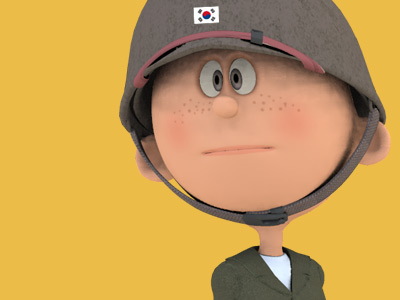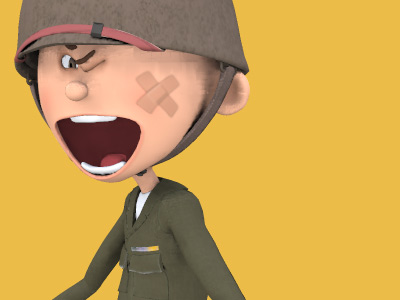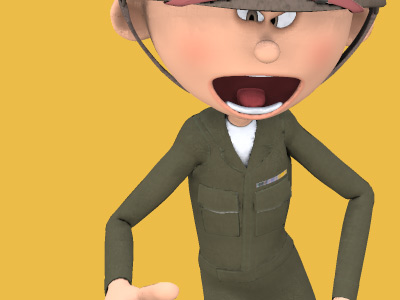Korean War 한국전쟁 (1950-1953)
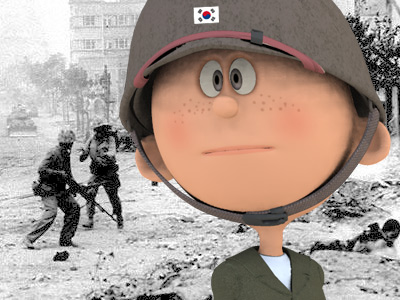
Stalemate (July 1951 – July 1953)
For the remainder of the Korean War the UN Command and the PVA fought, but exchanged little territory; the stalemate held. Large-scale bombing of North Korea continued, and protracted armistice negotiations began 10 July 1951 at Kaesong. On the Chinese side, Zhou Enlai directed peace talks, and Li Kenong and Qiao Guanghua headed the negotiation team. Combat continued while the belligerents negotiated; the UN Command forces' goal was to recapture all of South Korea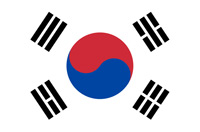 South Korea officially the Republic of Korea (ROK), is a country in East Asia, constituting the southern part of the Korean Peninsula and sharing a land border with North Korea. Since the 21st century, South Korea has been renowned for its globally influential pop culture, particularly in music (K-pop), TV dramas (K-dramas) and cinema, a phenomenon referred to as the Korean wave. and to avoid losing territory. The PVA and the KPA attempted similar operations, and later effected military and psychological operations in order to test the United Nations (UN)
South Korea officially the Republic of Korea (ROK), is a country in East Asia, constituting the southern part of the Korean Peninsula and sharing a land border with North Korea. Since the 21st century, South Korea has been renowned for its globally influential pop culture, particularly in music (K-pop), TV dramas (K-dramas) and cinema, a phenomenon referred to as the Korean wave. and to avoid losing territory. The PVA and the KPA attempted similar operations, and later effected military and psychological operations in order to test the United Nations (UN)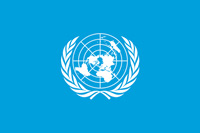 United Nations (UN) is an intergovernmental organization whose stated purposes are to maintain international peace and security, develop friendly relations among nations, achieve international cooperation, and be a centre for harmonizing the actions of nations. The UN was established after World War II with the aim of preventing future world wars, succeeding the League of Nations, which was characterized as ineffective. Command's resolve to continue the war.
United Nations (UN) is an intergovernmental organization whose stated purposes are to maintain international peace and security, develop friendly relations among nations, achieve international cooperation, and be a centre for harmonizing the actions of nations. The UN was established after World War II with the aim of preventing future world wars, succeeding the League of Nations, which was characterized as ineffective. Command's resolve to continue the war.
The principal battles of the stalemate include:
- Battle of Bloody Ridge (18 August–15 September 1951)
- Battle of the Punchbowl (31 August-21 September 1951)
- Battle of Heartbreak Ridge (13 September–15 October 1951)
- Battle of Old Baldy (26 June–4 August 1952)
- Battle of White Horse (6–15 October 1952)
- Battle of Triangle Hill (14 October–25 November 1952)
- Battle of Hill Eerie (21 March–21 June 1952)
- Sieges of Outpost Harry (10–18 June 1953)
- Battle of the Hook (28–29 May 1953)
- Battle of Pork Chop Hill (23 March–16 July 1953)
- Battle of Kumsong (13–27 July 1953)
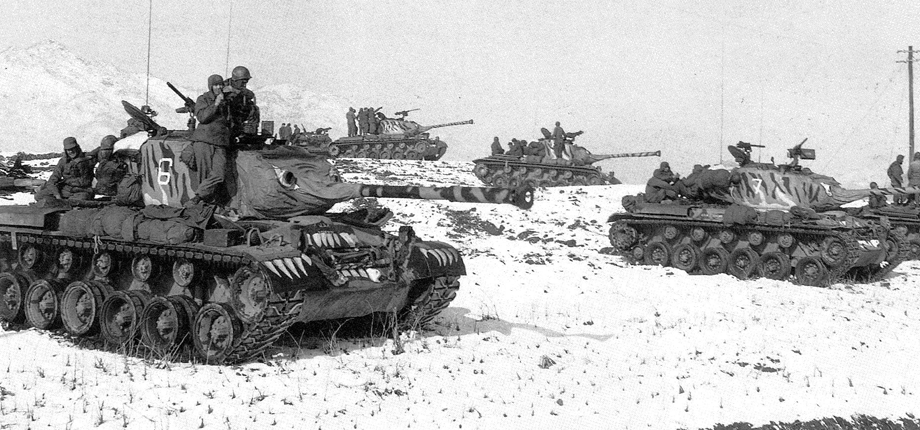
M46 tanks of the US Army 6th Tank Batallion, painted with tiger stripes and faces in order to frighten supposedly superstitious Chinese troops

M46 tanks of the US Army 6th Tank Batallion, painted with tiger stripes and faces in order to frighten supposedly superstitious Chinese troops
( Click image to enlarge)
Chinese troops suffered from deficient military equipment, serious logistical problems, overextended communication and supply lines, and the constant threat of UN bombers. All of these factors generally led to a rate of Chinese casualties that was far greater than the casualties suffered by UN troops. The situation became so serious that, on November 1951, Zhou Enlai called a conference in Shenyang to discuss the PVA's logistical problems. At the meeting it was decided to accelerate the construction of railways and airfields in the area, to increase the number of trucks available to the army, and to improve air defense by any means possible. These commitments did little to directly address the problems confronting PVA troops.
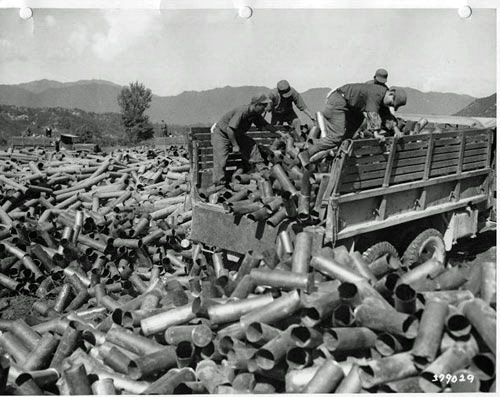
ROK soldiers dumping expended 155mm shell casings
In the months after the Shenyang conference Peng Dehuai went to Beijing several times to brief Mao and Zhou about the heavy casualties suffered by Chinese troops and the increasing difficulty of keeping the front lines supplied with basic necessities. Peng was convinced that the war would be protracted, and that neither side would be able to achieve victory in the near future.
On 24 February 1952, the Military Commission, presided over by Zhou, discussed the PVA's logistical problems with members of various government agencies involved in the war effort. After the government representatives emphasized their inability to meet the demands of the war, Peng, in an angry outburst, shouted: "You have this and that problem... You should go to the front and see with your own eyes what food and clothing the soldiers have! Not to speak of the casualties! For what are they giving their lives? We have no aircraft. We have only a few guns. Transports are not protected. More and more soldiers are dying of starvation. Can't you overcome some of your difficulties?"
The atmosphere became so tense that Zhou was forced to adjourn the conference. Zhou subsequently called a series of meetings, where it was agreed that the PVA would be divided into three groups, to be dispatched to Korea in shifts; to accelerate the training of Chinese pilots; to provide more anti-aircraft guns to the front lines; to purchase more military equipment and ammunition from the Soviet Union Soviet Union, officially the Union of Soviet Socialist Republics (USSR), was a transcontinental country that spanned much of Eurasia from 1922 to 1991. The Soviet Union fall process began with growing unrest in the Union's various constituent national republics developing into an incessant political and legislative conflict between them and the central government. Estonia was the first Soviet republic to declare state sovereignty inside the Union.; to provide the army with more food and clothing; and, to transfer the responsibility of logistics to the central government.
Soviet Union, officially the Union of Soviet Socialist Republics (USSR), was a transcontinental country that spanned much of Eurasia from 1922 to 1991. The Soviet Union fall process began with growing unrest in the Union's various constituent national republics developing into an incessant political and legislative conflict between them and the central government. Estonia was the first Soviet republic to declare state sovereignty inside the Union.; to provide the army with more food and clothing; and, to transfer the responsibility of logistics to the central government.
HISTORY
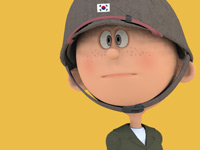
RESOURCES
This article uses material from the Wikipedia article "Korean War", which is released under the Creative Commons Attribution-Share-Alike License 3.0.
© Stories Preschool. All Rights Reserved.
